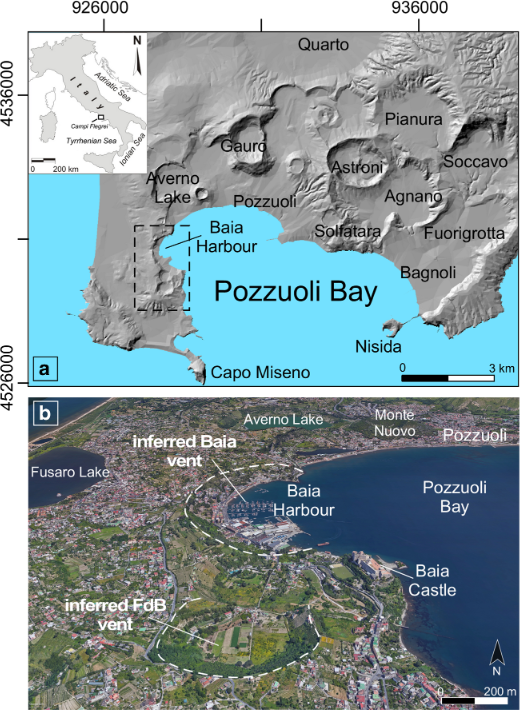Magmatic reactivation of the Campi Flegrei volcanic system: insights from the Baia–Fondi di Baia eruption

Voloschina M., M. Pistolesi, A. Bertagnini, N. Métrich, M. Pompilio, A. Di Roberto, S. Di Salvo, L. Francalanci, R. Isaia, R. Cioni, C. Romano (2018).
Bulletin of Volcanology, https://doi.org/10.1007/s00445-018-1247-8.
Abstract
The Baia–Fondi di Baia was a multi-stage, small-scale eruption which occurred in the western part of the Campi Flegrei caldera at 9525–9696 BP, marking the onset of Epoch 2 of post-Neapolitan Yellow Tuff volcanism. The eruption was characterized by a complex series of events related to two distinct eruptive episodes (Baia and Fondi di Baia) separated by a short time interval, and each characterized by several eruptive phases. Mineralogical, geochemical (major, and trace elements on whole rocks, major and volatile elements on matrix glasses, and melt inclusions), and Sr isotope characterization of the tephra material sampled along the entire sequence was carried out in order to constrain magmatic evolution and dynamics of the feeding system. Three main compositional groups were identified in matrix glasses and interpreted as representative of different magma bodies: (i) a trachyte (SiO2 60.3–64.7 wt.%), which is volumetrically predominant; (ii) a tephriphonolite-latite (SiO2: 55.1–57.9 wt.%); and (iii) an intermediate magma group between phonolite and trachyte compositions. This wide compositional heterogeneity contrasts with the narrow variability recognized in the bulk-rock compositions, which are all trachytic. Mineral, melt inclusions, and Sr isotope data suggest that the trachytic magma possibly derived from the Campanian Ignimbrite reservoir located at 6–9 km depth. Volatile content in matrix glass indicates a storage depth of at least 6 km for the tephriphonolite-latitic magma. The intermediate magma is interpreted as being derived from a remelting and assimilation process of a partially crystallized trachytic body (crystal mush) by the hotter tephriphonolite-latitic magma. As the tephriphonolite-latite was erupted together with the trachyte from the beginning of the eruption, we suggest that the ascent of this magma played a fundamental role in triggering the eruption. Upwards through the tephra sequence, we observed a progressive increase of the tephriphonolite-latitic and intermediate phonolite-trachytic components. The presence of banded clasts characterized by different compositions is also indicative of syn-eruptive mingling during the final phases of the eruption.


Devi effettuare l'accesso per postare un commento.